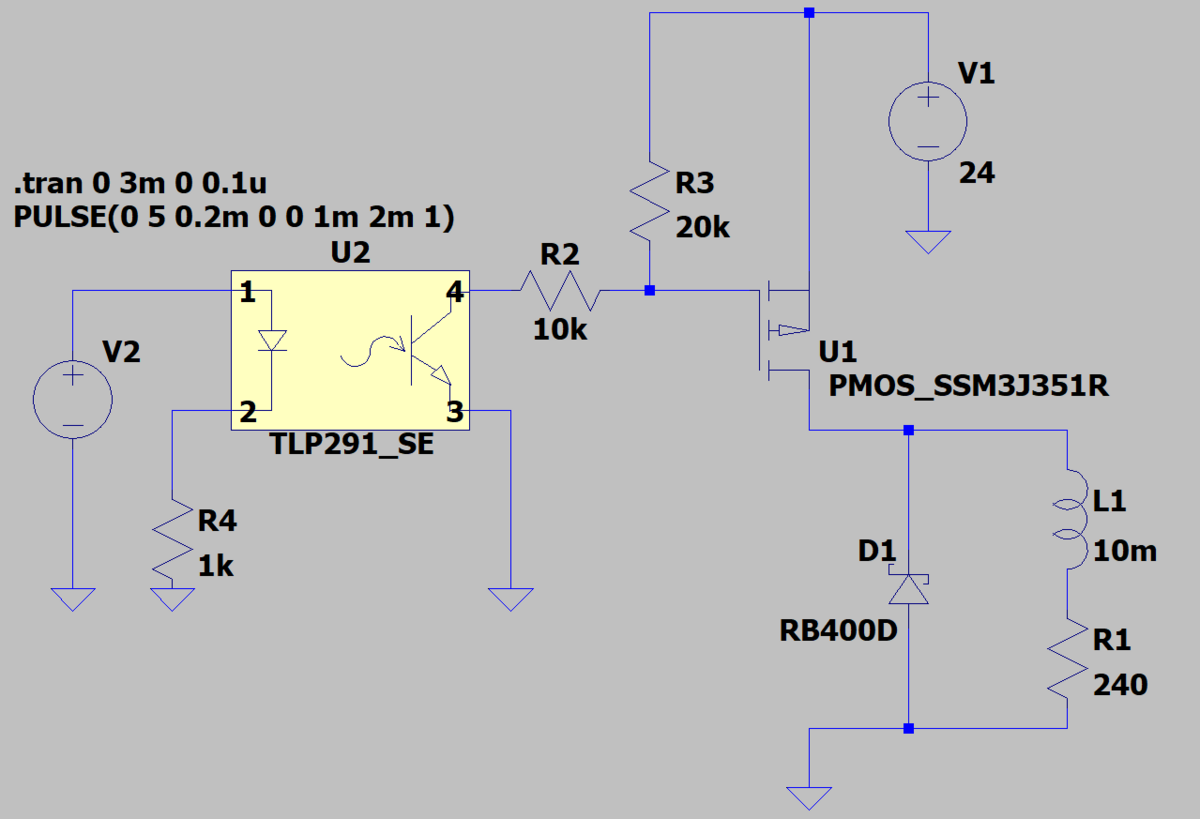LTspice with Python 2. シミュレーションの実行
LTspiceの電気回路シミュレータをPythonで利用する方法を紹介する
今回は、LTspiceで作成した回路図(.asc)を読み込み、Pythonでシミュレーションを実行する
回路図作成
PチャネルMOSFET (SSM3J351R) を使って、圧空系の電磁弁を駆動する回路を作成する
- ロジック側(5VD)とドライブ側(24VL)との分離のため、フォトカプラを間に使用する
- PチャネルMOSFETを使用して、電磁弁をソース駆動させる
- 電磁弁のインダクタンスによる逆起電圧の防止用にダイオードを追加する

シミュレーションの実行
ascファイルの読み込み
SimCommander を使って、ascファイルを読み込む
読み込むと同時に、netファイルが生成される
import matplotlib.pyplot as plt from PyLTSpice import SimCommander LTC = SimCommander("P-MOSFET.asc")
生成されたnetファイルを確認する
!more P-MOSFET.net
* c:\Users\XXXX\P-MOSFET.asc L1 N006 N007 10m R1 N007 0 240 V1 N001 0 24 R2 N004 N003 10k R3 N001 N004 20k V2 N002 0 PULSE(0 5 2m 0 0 10m 20m 1) R4 N005 0 1k D1 0 N006 RB400D XU1 N006 N004 N001 PMOS_SSM3J351R XU2 N002 N005 0 N003 TLP291_SE .model D D .lib C:\Users\XXXX\AppData\Local\LTspice\lib\cmp\standard.dio .tran 0 20m 0 1u .lib Contrib/Toshiba/LVMOS/SSM3J351R_G0_00.mod .lib importsub/TLP291_SE.mod .backanno .end
このネットリストを元にシミュレーションが実行される
シミュレーションの実行
上記のnetファイルに対して、シミュレーションを実行する
LTC.run('P-MOSFET_tmp.net')
LTC.wait_completion()
シミュレーションが実行され、結果のファイル(P-MOSFET_tmp.raw)が生成される
シミュレーション結果の確認
生成されたrawファイルを可視化する
from PyLTSpice import RawRead LTR = RawRead("P-MOSFET_tmp.raw") fig = plt.figure(figsize=(10, 4)) time = LTR.get_trace('time') step = 0 ax1 = fig.add_subplot(2, 3, 1) Vn006 = LTR.get_trace("V(n006)") ax1.plot(time.get_wave(step) * 1e3, Vn006.get_wave(step), label='V$_{out}$ = V$_{R1}$') ax1.set_xlabel('[msec]'); ax1.set_ylabel('[V]') ax1.legend() ax1.grid(which='both', ls=':') ax2 = fig.add_subplot(2, 3, 4, sharex=ax1) IR1 = LTR.get_trace("I(R1)") ax2.plot(time.get_wave(step) * 1e3, IR1.get_wave(step) * 1e3, label='I$_{out}$ = I$_{R1}$') ax2.set_xlabel('[msec]'); ax2.set_ylabel('[mA]') ax2.legend() ax2.grid(which='both', ls=':') ax3 = fig.add_subplot(2, 3, 2, sharex=ax1) Vn002 = LTR.get_trace("V(n002)") ax3.plot(time.get_wave(step) * 1e3, Vn002.get_wave(step), label='V$_{in}$') ax3.set_xlabel('[msec]'); ax3.set_ylabel('[V]') ax3.legend() ax3.grid(which='both', ls=':') ax4 = fig.add_subplot(2, 3, 5, sharex=ax1) IR4 = LTR.get_trace("I(R4)") ax4.plot(time.get_wave(step) * 1e3, IR4.get_wave(step) * 1e3, label='I$_{R4}$') ax4.set_xlabel('[msec]'); ax4.set_ylabel('[mA]') ax4.legend() ax4.grid(which='both', ls=':') ax5 = fig.add_subplot(2, 3, 3, sharex=ax1) Vn004 = LTR.get_trace("V(n004)") ax5.plot(time.get_wave(step) * 1e3, Vn004.get_wave(step), label='V$_{Gate}$') ax5.set_xlabel('[msec]'); ax5.set_ylabel('[V]') ax5.legend() ax5.grid(which='both', ls=':') ax6 = fig.add_subplot(2, 3, 6, sharex=ax1) IR2 = LTR.get_trace("I(R2)") ax6.plot(time.get_wave(step) * 1e3, IR2.get_wave(step) * 1e3, label='I$_{R2}$') ax6.set_xlabel('[msec]'); ax6.set_ylabel('[mA]') ax6.legend() ax6.grid(which='both', ls=':') fig.tight_layout()

シミュレーションが正常に実行できている
私の拙い知識で書いておりますので、誤り等ありましたらご指摘ください